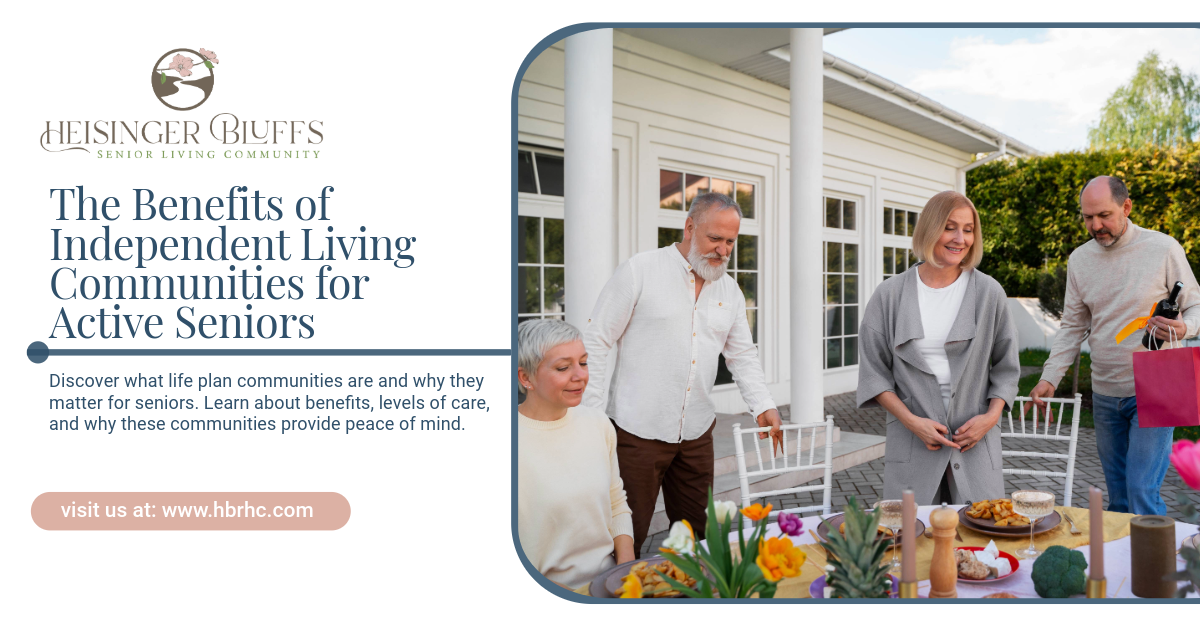The Benefits of Independent Living Communities for Active Seniors

Key Highlights
- Independent living communities promote freedom, independence, and convenience.
- Social engagement and community events reduce isolation and enhance well-being.
- On-site services and amenities simplify daily life for active seniors.
- Wellness programs support physical, emotional, and mental health.
- Choosing an independent living community allows seniors to focus on what they enjoy most.
As seniors enter retirement, many look for living arrangements that offer independence while providing support for daily needs. Independent living communities are designed to meet this goal, allowing active seniors to enjoy a vibrant lifestyle without the responsibilities of home maintenance.
These communities provide more than just a place to live—they offer a lifestyle, social connections, and access to amenities that support health and well-being. In this blog, we’ll explore the benefits of independent living communities and why they matter for seniors who want to live life to the fullest.
What Are Independent Living Communities?
Independent living communities are residential communities specifically designed for seniors who are generally able to live on their own but want convenience, security, and social engagement. Unlike assisted living or nursing care facilities, independent living focuses on lifestyle and personal freedom, rather than healthcare.
Typical features include:
- Apartment-style or cottage-style living with maintenance-free options
- Housekeeping, laundry, and meal services
- Access to recreational facilities and organized social activities
- Transportation services for errands, appointments, and outings
Benefits of Independent Living Communities
1. Maintenance-Free Living
One of the most significant advantages is freedom from household chores and maintenance. Seniors no longer need to worry about lawn care, home repairs, snow removal, or cleaning. This allows them to spend more time enjoying hobbies, travel, and social activities.
2. Social Engagement
Independent living communities provide numerous opportunities for social interaction. Organized events, group outings, fitness classes, and hobby clubs help seniors make friends, combat isolation, and enjoy a sense of belonging. Social engagement has been linked to improved mental and emotional health, which is especially important for active seniors.
3. Wellness and Fitness Opportunities
Many communities offer wellness programs that promote physical activity and health. These can include:
- On-site fitness centers and group exercise classes
- Swimming pools and walking trails
- Yoga, tai chi, and meditation sessions
- Nutrition counseling and healthy dining options
These programs help seniors maintain strength, flexibility, and overall well-being.
4. Safety and Security
Independent living communities often provide enhanced safety features:
- Gated access and security personnel
- Emergency response systems in residences
- On-site staff available for assistance when needed
Knowing help is readily available adds peace of mind for both residents and their families.
5. Convenience and Accessibility
Living in a community designed for seniors makes daily life easier:
- On-site dining reduces meal prep stress
- Transportation services assist with shopping, medical appointments, and social outings
- Access to cultural, recreational, and educational activities on-site or nearby
This convenience allows seniors to focus on activities they enjoy rather than logist1ics and chores.
How Independent Living Communities Promote an Active Lifestyle
| Feature | Benefit for Seniors |
|---|---|
| Fitness Programs | Improve strength, balance, and cardiovascular health |
| Group Activities | Encourage social connections and mental stimulation |
| Hobby & Arts Classes | Provide creative outlets and reduce stress |
| Transportation Services | Enable outings and travel without reliance on personal vehicles |
| Wellness Checks | Support proactive health management |
By providing structured programs and opportunities for engagement, these communities empower seniors to stay active physically, mentally, and socially.
Financial Considerations
Independent living communities often require a monthly fee that covers housing, some meals, amenities, and services. Costs vary depending on location, residence size, and included amenities.
Some communities offer flexible options, including:
- Rental agreements for those who prefer lower upfront costs
- Entrance fees for long-term residents seeking stability and additional perks
Understanding these financial options helps seniors and families plan for a comfortable, sustainable lifestyle.
Who Should Consider Independent Living Communities?
Independent living communities are ideal for:
- Seniors who want an active, maintenance-free lifestyle
- Individuals seeking social engagement and community connections
- Retirees looking for convenient access to wellness and recreational activities
- Seniors who value safety, security, and on-site support services
- Couples or individuals who want to age in place while maintaining independence
Tips for Choosing the Right Independent Living Community
When exploring communities, consider the following factors:
- Amenities and Services: Do they align with your lifestyle and needs?
- Location: Is it close to family, friends, or healthcare providers?
- Social and Recreational Opportunities: Are there activities you enjoy?
- Financial Options: Can you afford the monthly fees or entrance costs?
- Resident Satisfaction: Talk to current residents about their experience.
- Accessibility and Safety: Are safety measures adequate for your comfort?
Visiting multiple communities and asking detailed questions helps ensure you find the best fit for your lifestyle and long-term goals.
Final Thoughts
Independent living communities offer active seniors a unique combination of independence, convenience, and community. From maintenance-free living and wellness programs to social engagement and security, these communities help seniors live life fully while reducing stress and responsibilities.
At Heisinger Bluffs, our independent living community provides a vibrant environment where seniors can enjoy freedom, wellness, and meaningful connections—creating the perfect foundation for a fulfilling retirement. Reach out today!
Frequently Asked Questions
What is the difference between independent living and assisted living?
Independent living focuses on lifestyle, social activities, and convenience, while assisted living provides help with daily tasks such as bathing, dressing, and medication management.
Are independent living communities expensive?
Costs vary based on location, residence size, and amenities. Many communities offer flexible financial options, including rental agreements or entrance fees.
Can I bring my pet to an independent living community?
Many communities welcome pets, but policies vary. It’s important to check pet restrictions and amenities before deciding.
What types of activities are offered?
Communities offer a variety of activities, including fitness programs, hobby and arts classes, social events, cultural outings, and educational workshops.
Is independent living suitable for seniors with minor health concerns?
Yes. While residents are generally independent, on-site support, wellness programs, and emergency systems provide added safety for seniors with minor health concerns.
Sources:
- https://mcpress.mayoclinic.org/healthy-aging/a-surprising-key-to-healthy-aging-strong-social-connections/
- https://www.ncoa.org/page/healthy-aging-programs/
- https://medlineplus.gov/nutritionforolderadults.html
- https://www.nia.nih.gov/health/healthy-aging/participating-activities-you-enjoy-you-age











